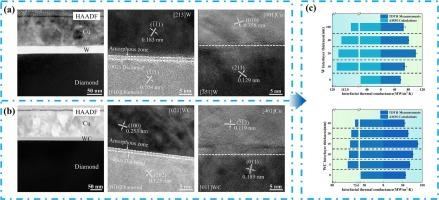层间厚度与纳米级金刚石/Cu界面导热系数的关系
IF 6.9
2区 材料科学
Q2 CHEMISTRY, PHYSICAL
引用次数: 0
摘要
为了阐明层间厚度与金刚石/Cu界面热导率(ITC)之间的关系,采用磁控溅射法制备了不同层间厚度的金刚石/W(WC)/Cu纳米层结构,并利用时域热反射(TDTR)系统直接测量了其ITC。结果表明,过薄的夹层增强了界面散射,从而缩短了热载流子的有效平均自由程(MFP),从而抑制了热输运,限制了整体导热系数。当层间厚度接近热载流子的MFP时,界面散射的显著降低促进了界面间输运,W(20 nm)和WC(15 nm)的ITC峰值分别为101.5 MW/(m2·K)和88 MW/(m2·K)。然而,进一步增加层间厚度会引入相当大的体热阻和缺陷散射,从而降低热载流子的输运效率,最终降低金刚石/Cu界面处的ITC。本文章由计算机程序翻译,如有差异,请以英文原文为准。

Correlation between interlayer thickness and diamond/Cu interfacial thermal conductivity at the nanoscale
To elucidate the correlation between the interlayer thickness and the interfacial thermal conductivity (ITC) of the diamond/Cu interface at the nanoscale, diamond/W(WC)/Cu nanolayered structures with varying interlayer thicknesses were prepared by magnetron sputtering, and their ITC was directly measured by time-domain thermoreflectance (TDTR) system. The results indicate that an excessively thin interlayer enhances interfacial scattering, thereby shortening the effective mean free path (MFP) of hot carriers, which suppresses thermal transport and limits the overall thermal conductivity. When the interlayer thickness approaches the MFP of hot carriers, the significantly reduced interfacial scattering promotes cross-interface transport, resulting in peak ITC of 101.5 MW/(m2·K) for W (20 nm) and 88 MW/(m2·K) for WC (15 nm), respectively. However, further increasing the interlayer thickness introduces considerable bulk thermal resistance and defect scattering, which decreases the transport efficiency of hot carriers and ultimately reduces the ITC at the diamond/Cu interface.
求助全文
通过发布文献求助,成功后即可免费获取论文全文。
去求助
来源期刊

Applied Surface Science
工程技术-材料科学:膜
CiteScore
12.50
自引率
7.50%
发文量
3393
审稿时长
67 days
期刊介绍:
Applied Surface Science covers topics contributing to a better understanding of surfaces, interfaces, nanostructures and their applications. The journal is concerned with scientific research on the atomic and molecular level of material properties determined with specific surface analytical techniques and/or computational methods, as well as the processing of such structures.
 求助内容:
求助内容: 应助结果提醒方式:
应助结果提醒方式:


